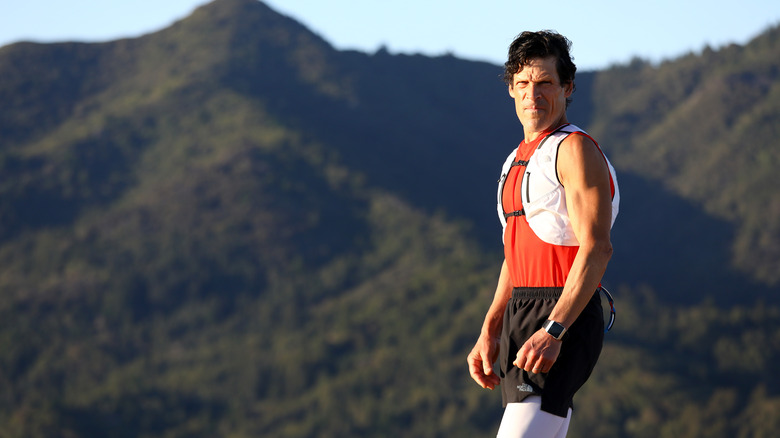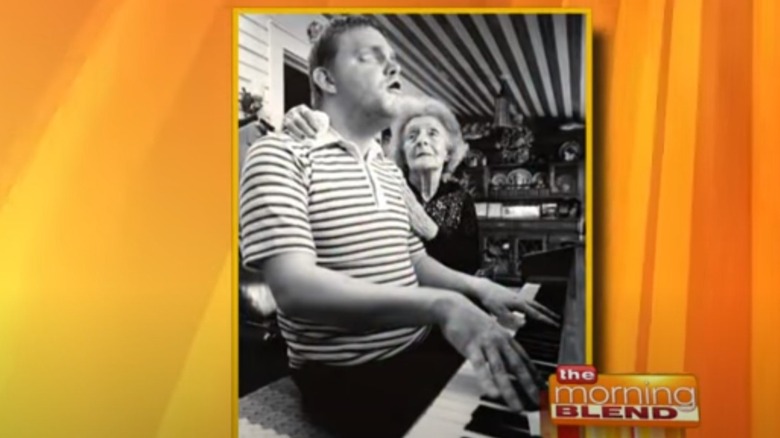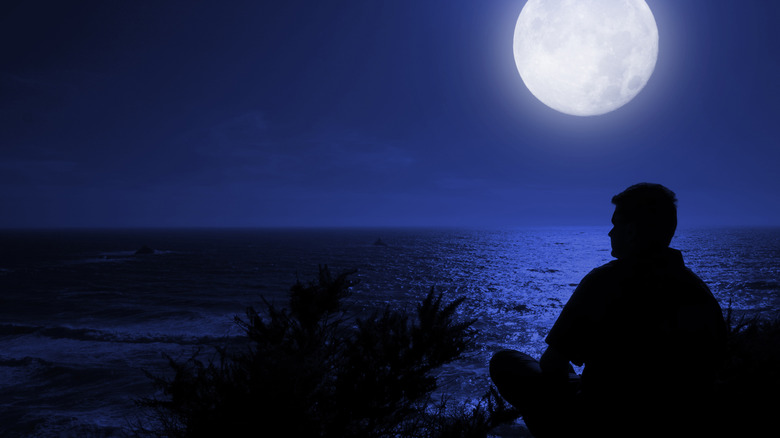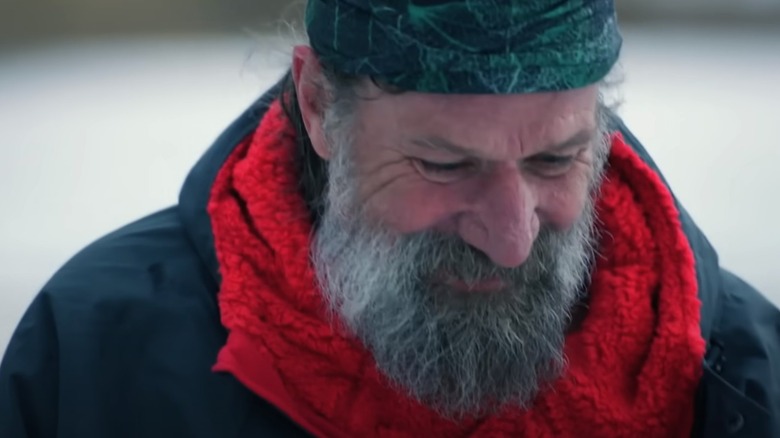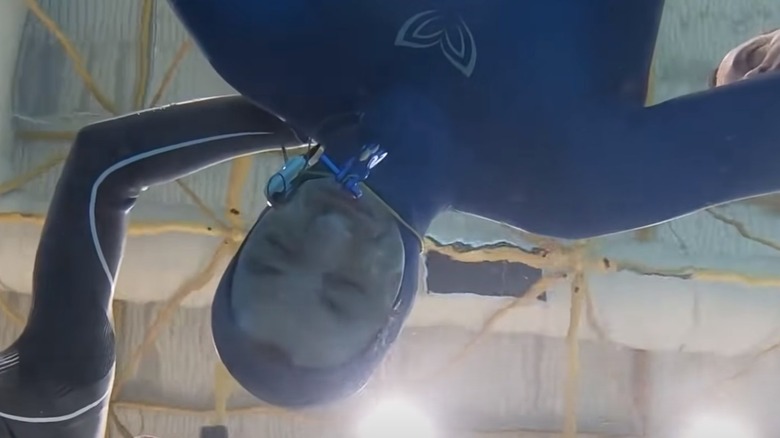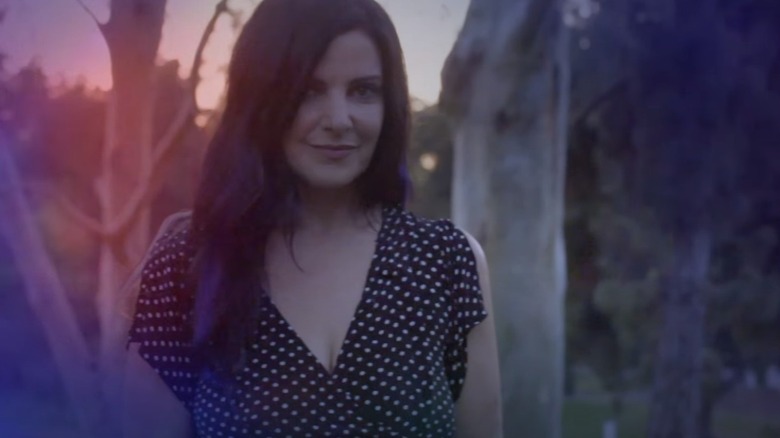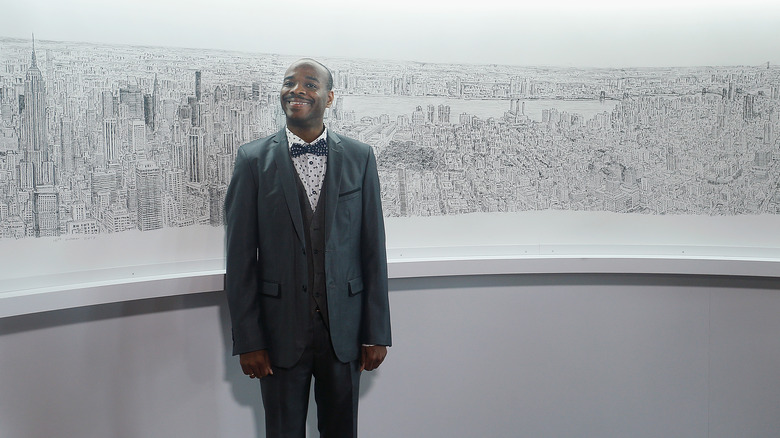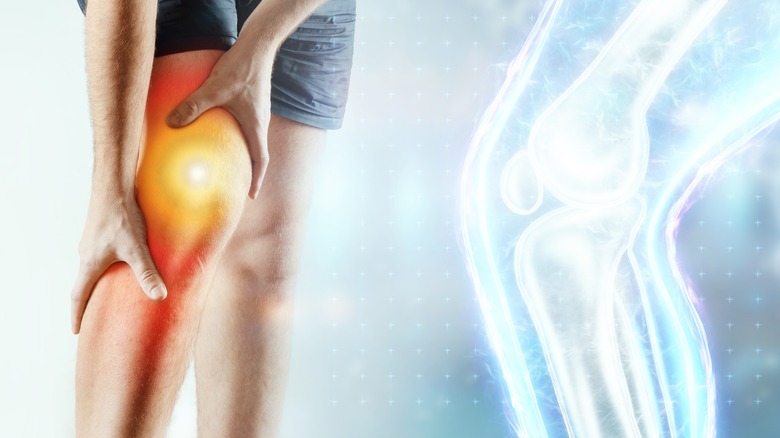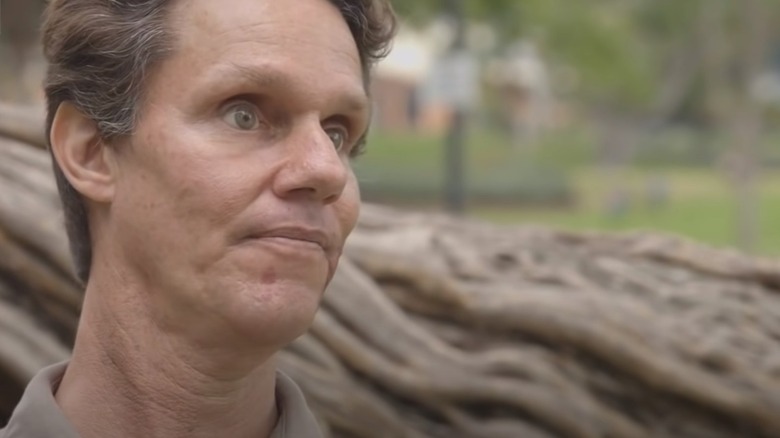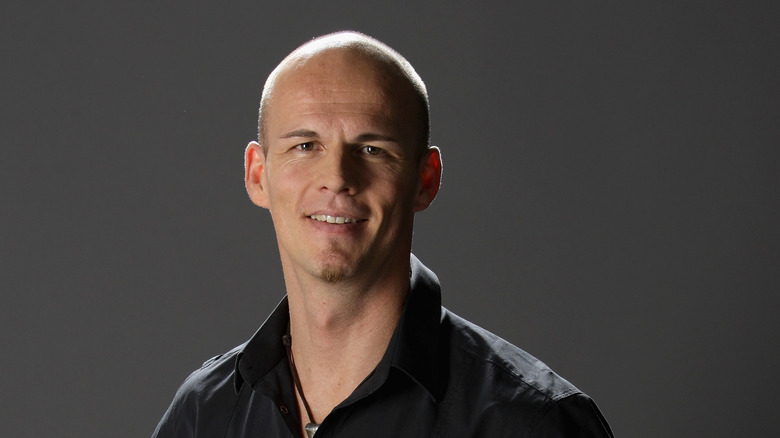Strange Superpowers People Have In Real Life
It's a scientific fact: It's 100% impossible to sit through any superhero movie without dreaming about having real-life superpowers. Whether that's the ability to fly, have super strength, see through walls, shapeshift, control the weather ... the possibilities are literally endless, along with the ways one might imagine taking over the world. Or, let's be honest — part of being a grown-up means that taking over the world is too much work, and retreating to a private island somewhere warm might be preferable.
But superpowers don't exist ... do they? They absolutely do, and here's the good news: Not everyone is born with them, and in some cases, people have trained their bodies to do incredible things. It takes hard work, some serious dedication, and incredible focus, but in some cases, it can be done.
Not, however, in all cases. Unless you're born with it, you're likely not going to be able to see colors indistinguishable to most human eyes, or withstand pain. Some people can, though, and it's more than just possessing a neat party trick that gets inevitably requested at every get-together. Instead, it's possessing some abilities that bend science to the breaking point.
Running forever: Dean Karnazes
There are two kinds of people in the world: those who love running, and those who think anyone who says they love running is a liar. But then, there's also Dean Karnazes, who can run for just about forever — and he has. Karnazes has run hundreds of miles in all kinds of conditions, including a South Pole marathon in sub-zero temperatures. In 2005, he ran 350 miles in 80 hours and 44 minutes non-stop, and in the following year, he ran 50 marathons in 50 days. Strangest of all? He's never once felt the cramps and burning pain that makes most ordinary people stop running after just a short distance.
He told The Guardian, saying, "To be honest, what eventually happens is that I get sleepy. I've run through three nights without sleep, and the third night of sleepless running was a bit psychotic. I actually experienced bouts of 'sleep running,' where I was falling asleep while in motion, and I just willed myself to keep going." How?
In 2006, he visited a testing center that could measure various biological processes that governed athletic ability, and he says that he was pretty ordinary until they tested his lactate threshold. In a nutshell, as glucose breaks down into energy, it creates lactate. When it's made faster than it's flushed out of the blood, that's what causes the pain. Karnazes's body doesn't accumulate lactate, no matter how far he runs — and that basically means that he can run, pain- and cramp-free, forever.
Unbreakable bones: Timothy Dreyer
Timothy Dreyer is a researcher at the Bloomsbury Centre for Skeletal Research, and he has a unique insight into the thing that he's researching: He lives with it. Dreyer is one of only a handful of people who have been diagnosed with a condition called sclerosteosis, which means that his superpower is having unbreakable bones. In an interview with News 24, he spoke about living with the condition that he describes this way: [It's] actually pretty cool, because that means we don't break bones as often or ever when compared to people with normal life, right? However, there is a bad side to this."
Dreyer went on to explain that some of the side effects include things like hearing loss, facial palsy, and susceptibility to increased pressure on the brain, with sometimes fatal consequences. He was diagnosed when he was just 20 months old, fortunately, as it was followed by a series of surgeries to relieve the pressure on his bones.
Indiana University's Richard Gunderman says (via The Conversation) that there are a few other instances that bone specialists have documented cases of anonymous patients with abnormally strong bones, and it's not always a good thing. While it allowed one man to walk away from a major car accident without a single fracture, another had gone through hip surgeries that repeatedly failed because his bones were so tough that surgeons couldn't drill into them. The hope is that study of the condition might lead to a breakthrough in the treatment of osteoporosis.
Musical genius: Leslie Lemke
The general consensus is that it takes somewhere between 10 and 15 years of daily study and practice to master an instrument. Leslie Lemke needed quite a bit less than that. Specifically, none at all.
Lemke plays the piano, but more than that, he can flawlessly replicate any piece of music after hearing it just once. He never forgets the music he hears, and he can even sit down alongside another pianist and play what they play, with just around a 3-second delay. That's impressive, but it's about to get more impressive: Lemke has never had any formal training in the piano, can't read music, and when he was several months old, he developed a condition that necessitated the removal of his eyes. When he was featured on ABC's "That's Incredible," they shared that he had difficulty controlling his muscles, holding items, and performing basic tasks like getting out of bed by himself. He couldn't speak, but he could sing.
Dr. Darold Treffert is an expert in savant syndrome, and in a piece in Scientific American, he says Lemke's extraordinary abilities support the case for multiple intelligences, which is basically the idea that so-called "traditional intelligence," or the one that's measured by IQ scores, is just one facet of wider abilities. Treffert explains that to him, Lemke is proof that sometimes intelligence comes "factory installed," saying, "To me, the only mechanism that makes this possible is 'genetic' or 'ancestral' memory. ... They inherit the 'nature' part of the genius equation."
Never slept: Paul Kern
Let's start by saying that it's not unheard of for people to get by on just around four hours of sleep. But none? That's tricky. In 1904, The New York Times ran an article about a man named Albert Herpin, who claimed he hadn't slept in the 10 years or so since the death of his wife. Some doctors claimed that his nervous system simply wouldn't let him sleep, but when he died in 1947, a follow-up article was a little more skeptical. But then, there's Paul Kern.
Kern was a Hungarian soldier who fought in World War I, and his case was documented by We Are the Mighty. In 1915, he found himself facing off against the enemy on the Russian front and was shot in the head. He survived, but between sitting up in the field hospital and his death in 1955, he didn't sleep a wink. At all. Nada. Not even dozing off.
Kern reported no other side effects, and in fact, his only complaints were the monetary cost of staying awake 24 hours a day, and the fact that his eyes would ache if he didn't close them for an hour or so a day — but he was still awake. Scores of doctors examined him, and the closest anyone ever came to an explanation was that his head injury had only destroyed the part of his brain that required sleep. Beyond that, though, no one was quite sure what to make of his extraordinary ability.
Impervious to cold: Wim Hof
Anyone who's ever had to shovel their car out of a snowbank may have wished for a superhuman resistance to cold, and Wim Hof says that he not only has it, but that he can teach the ability to others. Hof has showcased his abilities in a series of incredible demonstrations that would have sent mere mortals to the hospital with hypothermia, including heading out into sub-zero temperatures for a hike (while dressed for summer weather), and spending hours sitting in freezing water. Monitoring shows that he's able to maintain a safe internal, core temperature ... so what gives?
Hof says that he uses a technique similar to that taught by yogis who are trained in a tantric Buddhist practice called tummo breathing — or "inner fire," — and can similarly survive the sub-zero temperatures of the Himalayas. Medical News Today says that when Western medicine started studying those who trained in it, they confirmed that by entering a deep meditative state, it was possible to raise body temperatures.
In 2018, researchers from Wayne State University released the findings of a study conducted with Hof. In it, he was dressed in a full-body suit, monitored with an MRI machine, and results confirmed that yes, activity in a part of the brain that controlled the interpretation of pain was connected to his ability to regulate his body temperature in the face of extremes. Researchers also acknowledged that it could be taught, saying it may be an invaluable practice for helping to manage chronic conditions.
No need to breathe: Aleix Segura and Budimir Sobat
According to Healthline, most people can hold their breath for between 30 seconds and two minutes. Eventually, a lack of oxygen to the brain results in blacking out and the lungs taking over, which makes the abilities of Aleix Segura and Budimir Sobat (pictured) that much more impressive.
In 2016, Segura beat his own best time to secure his place in the Guinness Book of World Records for holding his breath for a shocking 24 minutes and 3 seconds. He thought it was secure, at least, until Sobat beat it first in 2018 (with a time of 24 minutes and 11 seconds), and then again in 2021 (with a time of 24 minutes and 33 seconds).
How? It's tricky, and Sobat would seem to be proof that anyone can learn to do it. He only started diving when he was 48 years old, and set his second record when he was 56. In 2017, Segura explained how he did it to Wired, and it meant being prepared for the pain and the muscle spasms. And then? "When they start, you feel like you'll never make it. But you can fight it. You just fight it." University of Windsor associate professor of Kinesiology Anthony Bain notes (via The Conversation) that pre-breathing pure oxygen is standard practice ahead of attempts, but Sobat himself says, "All I am focused on is to try to hear my heartbeat. Once I heard it, I became calm and ready to fight all the time."
Ultra-color vision: Concetta Antico
Human vision has limits, which means that most people don't see the world like it really is. We don't see things like radio waves and X-rays, and when it comes to colors, there's actually a heck of a lot more out there than most people are aware of. The University of California, Irvine's Kimberly Jameson says (via the BBC) that most people can see about 100 different shades of each color, which means we can perceive about a million separate colors... give or take. Now, imagine what the world must look like to Concetta Antico. She's what's called a tetrachromat, which means she can see somewhere around 100 million different colors.
Antico is an artist, which has made her particularly popular with those studying the phenomenon. She told the BBC that in some places — like grocery stores — there's so much color that it's actually painful. So, what's going on here?
Dr. Jay Neitz is a color vision researcher at the University of Washington, and he told HuffPost that tetrachromatic vision is the result of a genetic abnormality that results in a person having four cones types in their eyes, instead of the usual three. He says that it's a mutation that only appears in women — and about 2% of all women have it — because an individual has to inherit the genetic mutation via two X chromosomes. Interestingly, there's something else these women have in common, aside from superhuman vision: Most have fathers or sons who are colorblind.
Photographic memory and recall: Stephen Wiltshire
Many people might even struggle to draw their own home from memory. Sure, you see it all the time, but accessing details is easier said than done ... but not for Stephen Wiltshire. Wiltshire can take one look at a landscape, cityscape, or building, then recreate it with stunning accuracy. He's sketched everything from the New York City skyline after a 20-minute helicopter ride to the historic cityscape of London, drawn to perfect scale.
Wiltshire discovered his extraordinary artistic ability when he was young. Diagnosed as autistic when he was three, he was first given pencils and paper in order to try to encourage communication. What teachers didn't expect was his astounding works of art. Among his favorite subjects? Animals and caricatures. He moved on to landmarks and buildings shortly after, and never looked back.
So, how does he do it? No one's 100% sure, but Australian National University and University of Sydney professor Allan Snyder has been working to unlock the mysteries of the abilities of the so-called savants. He told the BBC, "They are exceptional in that they can tap in and somehow we can't. They have privileged access." He believes that these incredible abilities are present in us all, but most people just don't know how to reach or interpret them. As for Wiltshire, how does he feel about his talent? He told The Guardian, "It makes me feel good and happy because it makes people smile, when they smile, I smile." And that might be the greatest superpower of all.
Immune to pain: Steven and Chris Pete
Of all the superpowers someone could have, it's immunity to pain that seems like it would be the best. Brothers Steven and Chris Pete were born with something called congenital analgesia, which basically means they can't feel pain — at all. But Steven explained to Mel that it isn't all it's cracked up to be.
Pain is essentially the human body's way of telling us that something's wrong, and without it, Steven says that he's had some severe injuries that could have cost him his life — and he didn't even know it. For example: He was snow tubing with his family when he flew off and hit the ground badly, and it was three months before he realized he'd broken his back in three places. He chewed off part of his tongue as a baby, and before he learned to manage his condition, he got hurt so often that child protective services removed him from his parents' care. He was in state care when he broke his leg again, and was finally taken seriously. In fact, he's broken his left leg so many times that he told the BBC it's only a matter of time before it has to be amputated.
For his brother, it was back injuries that not only threatened to leave him wheelchair-bound but facing a court decision that ruled he was ineligible for disability assistance because he couldn't feel pain. Steven wrote, "I can't help thinking congenital analgesia was partly why my brother chose to take his own life."
Natural numbers: Daniel Tammet
For some, their unique way of seeing the world makes them capable of incredible things. Take Daniel Tammet. His ability to recite pi to 22,514 places is just the beginning of his abilities, and he can also perform ridiculously complicated equations instantly, tell you what day of the week any date in history fell on, count the number of stitches in a shirt, and the leaves in a tree. Learning a language? He can do that, too — in about a week.
Psychology Today says Tammet has been diagnosed as being a high-functional autistic savant with an incredibly high IQ of somewhere around 150. Tammet says (via The Guardian) that the way he saw the world started to develop when he was 3 years old, and his fascination with counting started after he suffered from an epileptic fit. He explained: "When I multiply numbers together, I see two shapes. The image starts to change and evolve, and a third shape emerges. That's the answer. It's mental imagery. It's like maths without having to think."
It's still unclear just how Tammet taps into this incredible processing power, but he suggests it has something to do with his synesthesia. For him, every number between 1 and 10,000 has a unique form, and he described them to the Independent: One was a flashing light, and six was a chasm. "Numbers were the most real thing for me," he explained. "You could say that they form the way I look at the world. They are my first language."
Navigating with echolocation: Daniel Kish
If Batman can't use echolocation to find his way through a darkened city, what kind of superhero is he? Especially considering there are people who can use echolocation to navigate the world around them, even though they can't see it with their eyes. Daniel Kish explained to NPR that he's dubbed his ability "flash sonar," and simply put, he listens to the echoes of the clicking noises he makes to build up a picture of his surroundings.
"When I walk into a new area, the first thing I do is I take stock of the most prominent features. So in this particular area, the three most prominent features would be that building, the umbrella in the middle of this table, and the tree behind me," he explained. And yes, he can detect things like the difference between a tree and a column, and distinguish distinctive building features like balconies.
Kish lost his eyesight after being diagnosed with retinal cancer as a baby, and discovered his ability in a terrifying way: He first used it to judge how high he was while climbing trees. Kish has since started teaching others to do the same, and in 2014, researchers from the Ludwig Maximilian University studied just how he did it (via Science). They found it wasn't just a matter of clicking and listening, it involved the careful positioning of the head and upper body to receive the echoes. And yes — anyone can learn to do it: Kish teaches classes on it.
Extreme free-divers: David Vencl, Herbert Nitsch, Hanli Prinsloo
David Vencl, Herbert Nitsch (pictured), and Hanli Prinsloo are just a few of the free divers who regularly challenge the belief that once the human body gets to a certain depth, the extreme pressure means that lung collapse and a catastrophic death is imminent. Let's talk about some of these stats.
Herbert Nitsch set a shocking record in 2007, when he reached a depth of 702 feet while free-diving off the coast of Greece. Given that the pressure divers feel increases by one atmosphere every 10 meters, that means Nitsch was subjected to pressures 21 times the norm. (In 2021, he dove to 818 feet, but lost consciousness on the way up.) David Vencl, meanwhile, has hit record depths of 170 feet, but his dive took place beneath the ice-covered surface of the freezing Lake Sils in Switzerland. And Hanli Prinsloo has broken 11 free-diving records, after deciding she wanted to break the women's record and aim for a depth of 213 feet.
While physiology experts are starting to unlock the mysteries of just how they can do it, UCL physiology professor Kevin Fong explained to Popular Science that it's far from completely understood. They know pieces of the explanation — those depths and that pressure change the chemistry of the body and blood, and it means someone actually needs less oxygen to survive — but as for the whole picture? Fong calls it "a grey area between life and death in which there is a chance and things can happen."

